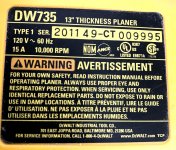[member=49475]patriot[/member] Concerning the Byrd head for your Dewalt 735 . . .
What is the age of your 735? If it's 5+ years old and has had heavy use, do you know what the expected life of the motor and other major components is? At this point, that is a prime concern of mine. Since my planer is more than 5 years old, does it pay to spend the money on the head upgrade at this point? While my planer hasn't had heavy use and I tend to plane 1/32" per pass or less, I have no idea how long it is projected to last. I've never seen any reported problems with its longevity, but anything can happen.
What is the age of your 735? If it's 5+ years old and has had heavy use, do you know what the expected life of the motor and other major components is? At this point, that is a prime concern of mine. Since my planer is more than 5 years old, does it pay to spend the money on the head upgrade at this point? While my planer hasn't had heavy use and I tend to plane 1/32" per pass or less, I have no idea how long it is projected to last. I've never seen any reported problems with its longevity, but anything can happen.

